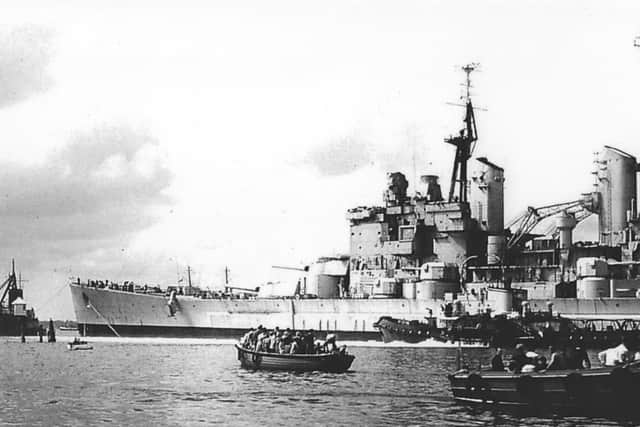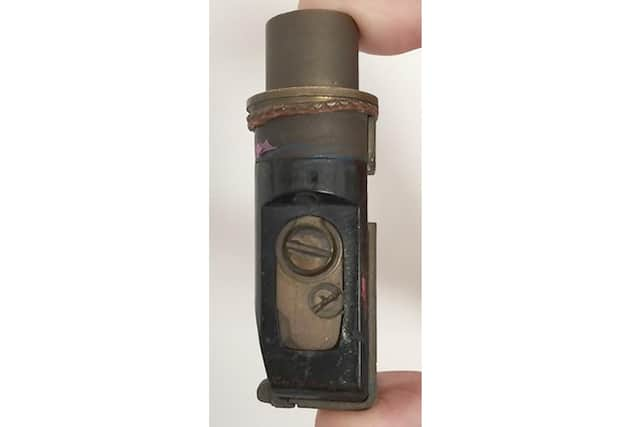Drama of the day HMS Vanguard almost turned up in Old Portsmouth pub | Nostalgia


Tim tells me: ‘I’ve seen dozens of photos of HMS Vanguard’s grounding at Point, Old Portsmouth, but not those of the Barry Cox collection.
'I was on the bridge of Vanguard with the Queen’s Harbourmaster and the Senior Pilot – the only journalist on board – and my brief was to write a colour feature for the next day’s paper.
Advertisement
Hide AdAdvertisement
Hide Ad‘That was until Vanguard began to slew off course and that started as we passed Middle Slip Jetty, where at one time Vanguard was veering towards an aircraft carrier – HMS Centaur I believe – that was berthed there and is just visible in Barry Cox’s first picture taken from Gosport Ferry Gardens.


'By the time we were passing South Railway Jetty, Vanguard’s immediate fate was sealed. The Admiralty harbour tugs Antic and Capable were simply not powerful enough, despite desperately working in unison to try to drag the bows to starboard.
'Only a split-second decision by Senior Pilot Roy Ottley prevented carnage among the hundreds of holidaymakers lining the walls at Point, who simply waved back at sailors on the fo’csle desperately shouting at them to run for their lives.
'Roy Ottley remembered that the old floating bridge chains had been left after the car ferry service ceased and ordered: 'Let go starboard anchor!' timing it so that the flukes grabbed the chains and hauled the bows away from where they were pointing directly at the pub and the massed crowds. In Barry Cox’s first picture, I was still on the bridge with a panoramic view of a disaster about to happen.
Advertisement
Hide AdAdvertisement
Hide Ad'In his second picture taken from the port side, I was sitting on a ready-use locker just for’ard of the twin 5.25-inch turret writing a story on a naval message pad I’d grabbed from the wireless cabin. I weighted it with a brass plug ripped from the cabin, wrapped the story, written in long hand, around with wire cable and tossed it over the side to an Evening News photographer in a press boat. Luckily he caught it and it made that day’s edition.


'Vanguard was aground for 45 minutes and the ocean-going tugs Samsonia and Bustler that were to take her to the Faslane scrapyard had to be brought in from Spithead to free 46,000 tons of armour from the putty.
It was a close call. Another 10 minutes and it was estimated the fast falling tide would have swung the stern around 90 degrees, blocking the harbour entrance. Not unlike the recent chaos in the Suez Canal.
'I still have the brass plug, a souvenir of one of the most dramatic stories I covered, concluded Tim
GREAT ESCAPE


Advertisement
Hide AdAdvertisement
Hide AdMy article on Leading Aircraftman Walker last week also drew comment from Tim, who tells me the following...
‘One of the tunnels used for The Great Escape has been excavated recently by British archaeologists who made some amazing discoveries.
'Prisoners had been working simultaneously on three separate tunnels in Stalag Luft III and had named them Tom, Dick and Harry.
‘It is Harry that the archaeologists have unearthed and found it to be virtually intact since 76 Allied aircrew escaped from it on the night of March 24 and 25, 1944, after which the Germans sealed it.
Advertisement
Hide AdAdvertisement
Hide Ad'The team also found another tunnel named George, which was not used as the prisoners were marched off to other camps as the Red Army approached.
'The camp was in western Poland and had lain undiscovered since the war, largely because it lay behind the Iron Curtain and the Russian occupiers had no interest in it.
'The archaeologists discovered dozens of bed boards were still propping up the 2ft wide, 111-yard-long tunnel which was 30 feet below ground .
‘There were also dozens of powdered milk tins that had been joined up to provide ventilation ducts.’
Advertisement
Hide AdAdvertisement
Hide AdTim adds: 'They found the entrance to Harry, which had been concealed under a heating stove in Hut 104, and scores of other items, such as metal buckets, hammers and crowbars which the prisoners of war had hidden from the German guards to use in the escape.’
PoW POST
You might remember that I also asked in that article about the Great Escape how mail was sent to prisoners of war from the UK, especially to a PoW camp in Poland.
My thanks go to boxing author Andrew Fairley. He tells me: ‘In answer to your question about how PoWs in Germany/Poland received mail, these efforts were co-ordinated by the International Red Cross, although I believe imperial Japan frustrated their work in that particular theatre.’
A message from the editor, Mark Waldron
You can subscribe here for unlimited access to our online coverage, including Pompey, for 27p a day.
Comment Guidelines
National World encourages reader discussion on our stories. User feedback, insights and back-and-forth exchanges add a rich layer of context to reporting. Please review our Community Guidelines before commenting.